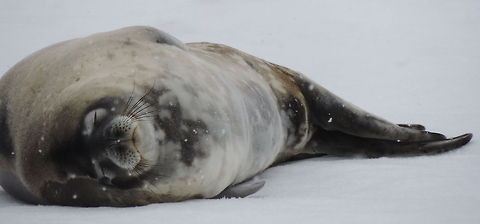
Behavior
Weddell seals gather in small groups around cracks and holes in the ice. These animals can also be found in large groups on ice attached to the continent. In the winter, they stay in the water to avoid blizzards, with only their heads poking through breathing holes in the ice. These seals are often observed lying on their sides, when on land. They are very docile and placid animals and can be approached easily.Depending on the latitude it inhabits, this marine mammal gives birth from early September through November, with those living at lower latitudes giving birth earlier. During the mating season, Weddell seals make noises loud enough to be felt through the ice. Copulation has only been observed to occur under water, where the female is often bitten on the neck by her partner. The seals are normally around six to eight years old when they first breed, but this can be much earlier for some females. The Weddell seal is one of the only species of seals that can give birth to twin pups. Birth of the pup only takes around one to four minutes. The pups take their first swim around one to two weeks old. They can hold their breath for five minutes, enabling them to dive to depths of 100 m . After six to seven weeks, they are weaned and begin to hunt independently. The average lifespan of a Weddell seal is about 30 years.
Habitat
The Weddell seal's natural habitat is ocean and sea ice surrounding Antarctica.Reproduction
Weddell seals gather in small groups around cracks and holes in the ice. These animals can also be found in large groups on ice attached to the continent. In the winter, they stay in the water to avoid blizzards, with only their heads poking through breathing holes in the ice. These seals are often observed lying on their sides, when on land. They are very docile and placid animals and can be approached easily.Depending on the latitude it inhabits, this marine mammal gives birth from early September through November, with those living at lower latitudes giving birth earlier. During the mating season, Weddell seals make noises loud enough to be felt through the ice. Copulation has only been observed to occur under water, where the female is often bitten on the neck by her partner. The seals are normally around six to eight years old when they first breed, but this can be much earlier for some females. The Weddell seal is one of the only species of seals that can give birth to twin pups. Birth of the pup only takes around one to four minutes. The pups take their first swim around one to two weeks old. They can hold their breath for five minutes, enabling them to dive to depths of 100 m . After six to seven weeks, they are weaned and begin to hunt independently. The average lifespan of a Weddell seal is about 30 years.
Food
Weddell seals eat an array of fish, krill, squid, bottom-feeding prawns, cephalopods, crustaceans, and sometimes penguins and other seals. A sedentary adult eats around 10 kg a day, while an active adult eats over 50 kg a day.Scientists believe Weddell seals rely mainly on eyesight to hunt for food when light is available. However, during the Antarctic winter darkness, when no light is available under the ice where the seals forage, they rely on other senses, primarily the sense of touch from their vibrissae or whiskers, which are not just hairs, but very complicated sense organs with more than 500 nerve endings that attach to the animal’s snout. The hairs allow the seals to detect the wake of swimming fish and use that to capture prey.
Weddell seals have no natural predators when on fast ice. At sea or on pack ice, they become prey for killer whales and leopard seals, which prey primarily on juveniles and pups. The Weddell seal is protected by the Antarctic Treaty and the Convention for the Conservation of Antarctic Seals.
Evolution
The Weddell seal shares a common recent ancestor with the other Antarctic seals, which are together known as the lobodontine seals. These include the crabeater seal , the Ross seal , and the leopard seal . These species share teeth adaptations including lobes and cusps useful for straining smaller prey items out of the water. The ancestral Lobodontini likely diverged from its sister clade, the Mirounga in the late Miocene to early Pliocene, when they migrated southward and diversified rapidly to form four distinct genera in relative isolation around Antarctica.References:
Some text fragments are auto parsed from Wikipedia.